The Cornell Lab Bird Academy › Discussion Groups › Joy of Birdwatching › Activities: Different Seasons, Different Birds
-
This is for #2 - Anna's Hummingbird, Northern Flicker, and Great Blue Heron are year round residents that I have seen in my area. In fact, I have seen pretty much all of the year round residents in my area - except the Brown Creeper, Red Crossbill, Peregrine Falcon and a few more. I have seen less of the species that only live here part of the year - but I have been lucky to spot the Black Turnstone, Brandt, and Barrow's Goldeneye. Love the diversity 0f birds in the Seattle area!
-
Wow, the cardinal does not migrate any distance - perhaps elevationally? It also sticks to the South and Eastern US. That it not apparent from the maps. The warbler crosses the Gulf of Mexico and makes its way North all the way to Hudson Bay, and probably needs a lot more resources (primarily fuel) than the cardinal, since it does not move around as much. I found it very interesting that the Tanagers both avoid the very middle of the country right down the midwestern states - perhaps they do not find food or refuge here. The Western Tanger sticks to just that - the western part of the US and Central America. But the Scarlet Tanager seems to occupy the longitudes that are farther east, reaching into South America and parts of Central America. The Rufous Hummingbird seems to start at higher latitudes in Central America/Mexico and sticks to the Western coastal areas in North America for the most part as it moves north in the spring/summer, but turn fall, it migrates back down to Central America over the mountains and surounding areas - the Rockies/Sierrra Nevadas. Ruby Throated stays more Easterly as it migrates north in the warmer months and never makes it past the midwestern US. Maybe they have evolutionarily adapted to the Eastern patchwork of vegetation, cities, and agricultural areas?
-
1. Northern Cardinal does not appear to really migrate and is in the eastern side of the country year round whereas the blackburnian warbler migrates up and down that same area only hitting the main cardinal range during migrant season. The Scarlet and Western Tanagers pretty much split the country in half only staying on there sides in the US and same in central and South America with a little overlap. The ruby throated hummingbird sticks to the eastern US and Mexico and C.A, while the rufous goes up the very west coast and down over the mountains on the west and stays west in Mexico as well. The Sandhill Crane appears to migrate sort of all over the place but not the east coast and not really past Texas and Florida, whereas the yellow bellied flycatcher is only the eastern part of the US. 2. Three species that are in my area that I see year round are the scrub jay, the song sparrow, which I see constantly, and the Great Blue Heron. It says the Oregon Junco is year round but I really only ever see it in the Winter. Three birds that are seasonal are the cackling goose, the sandhill crane, and the ruby-crowned kinglet all of which I saw this fall, for the first time. 3. Both the American Goldfinch and Common Loon have much more vibrant plumage in the the summer compared to the winter, I hate to say it but their winter plumages are quite drab in comparison and also explains why when a guide pointed out a Loon this winter I was like, meh, I would not have guessed that from the pics on Merlin, makes sense now why all the cool patterns and dark heads weren't there haha. 4. At my favorite local birding place it looks like I should be able to find an orange-crowned warbler, a Nashville warbler, and a Lazuli bunting none of which I have seen before.
-
ACTIVITY 4 - There is a birding spot, in Beverly Ma.. that I have found to be reliable. It is by the McDonalds' and Starbucks, on rte. 62. I have routinely seen Snowy Egrets, and Cormorants, as well as Ducks and Seagulls. It is a very reliable spot, and convenient, to photograph birds. They (the birds) seem to like the inlet, connected to the ocean. As well as the fish, and foraging rewards, in the water. I have never, not seen birds there, in the summer months. Also, Egrets, and Herons, are tough to find. But this place, always seems to have a Snowy Egret, and a few ducks. I have a picture of a Snowy Egret, and a Duck, from the shore. On the sidewalk, near the rocky beach. It is a great location for Wading-
 Birds/Waterfowl/Seabirds. From May, until Winter. SAMPLE ABOVE.
Birds/Waterfowl/Seabirds. From May, until Winter. SAMPLE ABOVE. -
Nice post! I'm in Massachusetts as well but have only been to coastal areas for birding a few times. Nice photo as well!
-
-
Activity 3 - The American Goldfinch, has a more colorful summer plumage, when compared to its' winter plumage. There is a crest type marking, on the crown, of the bird. It is an arrow shaped black mark. It also gives the illusion of a crest, but I do not think it sticks out at all. Not like a Titmouse. The belly, rump, and back of the bird, in the summer, has distinct yellow. But in the winter, it has dull yellow, light brown, markings. Also, in the winter, the black arrow shape, recedes. The winter plumage retains a little pure yellow, under the beak. But not nearly as much as in the summer. I have a photo of an A.G. in the summer of 2020. Massachusetts. A Common Loon, in the Summer, has checkered diamond patterns, on its' edge of the rump. And on its' shoulder. And on its' wings. Star type speckles, and A dark black head, and darker fine feathers, on its' head. Also, a 'necktie,' mark in its' neck. The Winter Common Loon, is plainer, with a white neck and belly color, and no 'ladder,' markings. Nor patterns. The dark black areas, seem to exchange
 color, into a dark grey. And there is no distinct, 'necktie.' Just a void in that area. Not as finely outlined.
color, into a dark grey. And there is no distinct, 'necktie.' Just a void in that area. Not as finely outlined. -
Activity 1 - I was interested in seeing the most likely time to see birds in Pennsylvania. Many I noticed simply pass through during migration, but it was cool to see some breed in our area and others that are here in the Mid-Atlantic states all year. I also found it interesting that some birds migrate in different routes, while most seem to fly North and South on the same route. I noticed one bird that flew up the West coast on it's way north, but came back through the mountains when it returned after breeding. Finally, I liked how you could see cool feats using the animation. One bird flew up through Mexico, but then seemed to disappear. Suddenly the migration appeared in the southern US. You can notice how it flew directly over the Caribbean.
-
Activity 2 - I would guess, the 3 birds that are permanent residents of the N.East, or at least migrate when, and if they want to. And short distances. Would be the Blue Jay, Northern Cardinal, and a Swan. I have seen each of these three, in winter months. And they may migrate, at their whim, shorter distances. Also a Chickadee, or a Junco. I have seen in snowy settings, and in winter months. I wonder, If they travel, a few states south, in a horrid winter. Or if they can stay,in the N.East, even in a deep freeze. A Red-Winged Blackbird, a Canada Goose, and an Ibis/Heron, or Crane order bird. I would guess, are migratory. I have read that RWB's, migrate at night, as the cold season hits. I have also seen so many Canada Geese fly south, in their arrow formation. That, we can all assume,


 means that they migrate. And are partial seasonal residents, depending on the region/area.
I would assume, that any Ibis/Crane order bird, would migrate to a Southern climate. I do not think a GBH, does better in the cold, than near, or past the south, the MASON DIXON LINE, area. However, some are called, 'SNOWY-EGRETS.' Is that because they can handle the snow, or is it an artistic name, for their white color. I have seen, in the Cornell maps, that Raptors and Terns, migrate through the N.EAST, and past the N.EAST. from North of the USA, and they go down to the south. I think they are decision migrants. Because, they are seen in all areas, in all seasons ? Are there Ospreys in CANADA and GEORGIA, in January, at the same time ? I dunno ?
means that they migrate. And are partial seasonal residents, depending on the region/area.
I would assume, that any Ibis/Crane order bird, would migrate to a Southern climate. I do not think a GBH, does better in the cold, than near, or past the south, the MASON DIXON LINE, area. However, some are called, 'SNOWY-EGRETS.' Is that because they can handle the snow, or is it an artistic name, for their white color. I have seen, in the Cornell maps, that Raptors and Terns, migrate through the N.EAST, and past the N.EAST. from North of the USA, and they go down to the south. I think they are decision migrants. Because, they are seen in all areas, in all seasons ? Are there Ospreys in CANADA and GEORGIA, in January, at the same time ? I dunno ? -
Activity 4: My favorite birding spot is Plum Island. I expect to find Snowy Owls, Northern Harrier, Cardinals, American Black Ducks, Pintails, Red-throated Loons, White-winged & Black Scoters, and Buffleheads. But six months from now, will be May of 2021 and the Warbler migration will just be beginning so we'll see Common Yellowthroat, Yellow Warblers, Baltimore Orioles, Eastern Towhees, House Finches and Goldfinches !
-
Plum Island is a great spot! I've only been a couple times as I'm a beginner (started birding this August), but both times I did see quite a few birds - especially raptors such as the Northern Harrier, Bald Eagle, Peregrine Falcons, Merlins, and numerous hawk species. One day I was with a group and we got a nice view of an Egret in flight. I also was up there November 2020 and know there was a Snowy Owl at Sandy Point, but didn't end up seeing myself. However I did see some very nice photos the next day on eBird.
-
-
Activity 3 - When I go to the Macaulay Library and study the plumage difference of the Male American Goldfinches in summer and winter, it is apparent that the Summer Male has striking Gold-Yellow coloring ! When I study the Winter plumage, legs, bill and wings are the same, but instead of the striking Yellow- Gold colors, this bird is more tawny and blends in with the back better ! _____________________________________________________________________________ When I go to the Macaulay Library and study the plumage difference of the Male Common Loon in summer and winter, it is apparent that the Summer Male has a strikingly, contrast black and white plumgae with a horizontal, black colored necklace across its throat. When I study the Winter plumage, the colors are a much more subdued gray and sometimes brownish color that contrasts the white belly, and the horizontal necklace band has disappeared all together !
-
Using Merlin’s “Likely Birds” feature I choose three species that live here year-round in the Northeast. As I live close to the coast, Mallards, Ring-billed Gulls and Common Eider are residents for is that we see each day we head out to Plum Island ! Bufflehead, Snow Bunting and Horned Grebe are here now (November) but we only get to enjoy them for part of the year. I like that Merlin shows so quickly the birds that we are likely to see, as well as showing when they will most likely arrive and depart. I use Merlin every day that I bird and it is so informative and easy to use !
-
The Yellow-bellied Flycatcher has an interesting migration pattern ! From observing the Range Map, this species spends over 7.5 months of the year Wintering in Central America. All at once this species quickly migrates North, but flying West of the Gulf of Mexico- up through the Mid-western States - across to the Northeast and Central regions of Canada. It appears that they complete this Northward migration in less than 2 weeks ! They then appear to spend about 2 months at the breeding grounds in Canada, before they start a fast Southern migration by returning to Central America ! They spend the most months of the year in Central America ... make a swift North and Northeast migration into Canada ... quickly get their successful breeding done ... and rapidly descend across the USA back into Central America. It is not quite clear from the Range Map, but I believe many of these Y-B Flycatchers return to Central America by flying West of the Gulf of Mexico, while others make the non-stop cross Gulf of Mexico flight from Louisanna ! This is an amazing migration !
-
The Sandhill Crane has a very interesting and different migration pattern from other birds. This Crane Winters in three areas, Texas, Florida and South of the Great Lakes of the USA. After observing the Range Map, each of these 3 groups appear to migrate differently The group that Winters in Texas migrates North through the Mid-Western US States, into Canada and some head West to Alaska while others appear to go all the way to the Artic for the breeding season ! The second group Winters South of the Great Lakes and appears to split their group up, with some migrating in a Northwesterly direction while the other half of the group appears to migrate in a Northeasterly direction into Canada. This second group migrates a great distance, but much less than Group 1. Then we have the 3rd Group that Winters in Florida. Some, but much less than half of this group, migrate North to the Great Lakes and meet up with Group 2 to head to the Canada breeding grounds. When Group 2 migrates back South, the members of Group 3 travel with them, but it appears that they return all the way to Florida, while the original Group 2 members stop when they reach the area just South of the Great Lakes ! I wonder why some of this species (Group 2) prefer to Winter in the cold weather just South of the Great Lakes while the other two Groups (1 & 3) migrate all the way South to the warm temperatures of Texas and Florida / and why does Group 1 travel so far North to Alaska and perhaps the Artic to breed, when it is apparent that many of Group 3 never leave Florida - so they breed there ?
-
The Rufous Hummingbird Winters for 5 to 6 months in Central America. It makes a Western migration up into the USA along the California Coast all the way up into Canada. It does not spend a great deal of time in the breeding grounds, before it migrates swiftly South and they fly West of the Rockies and all the way back to Central America. Most of this species makes the entire migration from South to North back to South !
-
The Ruby-throated Humminbird Winters in Central America and Florida for 5 months of the year. They make a fast moving Northward migration across the Gulf of Mexico and land in the Southern USA. From there, they spread out as far as the East Coast and rapidly move all the way to Canada and they spend 4 months breeding, and Summering in the North. From there they make rapid reverse migration along the same routes all the way back to Central America. _______________________________________________________________________________________________________________________ The Rufous
-
The Scarlet Tanager Winters in South America for several of the Winter months of the year. They then rapidly head North West into Central America, where they they fly across the Gulf of Mexico and land in the Southern USA, East of Texas. They then continue to speed Northward towards Northern USA and Canada where they Summer (breeding) for a three months. Then by September 1 they reverse their migration routes and close the distance back to Central America and then down into South America very quickly. I wonder why they travel so far and why they are traveling so fast to reach the two final destinations of the Northern breeding grounds and the Southern Wintering grounds ? Why fly so far and take so much risk ? Food ? Temperature ? What's the hurry ? The Western Tanager Winters for 5 months of the year in Western Central America. It begins its very quick migration right after April 1st by flying along the West Coast of Central America, along the California Coast and West of the Rocky Mountains and up into Canada to breed. They spend only a few weeks in Northwestern USA and Canada (breeding) and then return swiftly to Central America by reversing their route. It appears from the migration map that many of the Western Tanager only migrate 1/3 of the way, breeding (in New Mexico) and then returning to Central America. How come many of these Tanagers fly all the way to Canada while others fly a much shorter distance, maybe not even North of Central America or just over the border in the USA ? I think that the Western Tanager must be an efficient breeding species as it spends only a few weeks breeding ! Wow !
-
Activity # 1 - I observed that the Northern Cardinal has a much bigger migration range, East of the Mississippi. Filling the coast of the USA, north and south. The Blackburnian Warbler stays in South America for most of the early part of the year, and then they have remarkably fast migrations through the USA, as they quickly head North into Canada. The Blackburnian doesnt even hang around long during the mating season, as they then quickly fly through the USA and reside in South America again for the Winter !
-
ACTIVITY 1 - the Northern Cardinal is ranged more, East of the Mississippi. Filling the coast of the USA, north and south. I have heard that the 'pyrrhuloxia,' a relative of the Cardinal, is West of the Mississippi. The Blackburnian Warbler is ranged, in its' general, yearly abundance, further north, and further south. ----------------------------------------------------------------------------------------------------------------------------------------- The Scarlet Tanager, has Northern population, and southern population. As related to the USA and Central America, and Northern-South America. The Western Tanager, is west of the Mississippi, as noted in its' name. And is a different form of Tanager.
 The Scarlet T., is red with black wings. The Western T., has yellowish colors, and more markings. Not as solid in coloring.
-----------------------------------------------------------------------------------------------------------------------------------------
The Ruby Throated Hummingbird is an East of the Mississippi-bird, in general population. The Rufous Hummingbird is west and south of the Mississippi. I would assume less population in northern areas, due to the need of flowers to feed from. Are Hummingbirds migrating more south than other birds ? Sooner ?
-----------------------------------------------------------------------------------------------------------------------------------------------
The SandHill Crane, has a scattered population, in its' year round sum of population. The Yellow Bellied FlyCatcher is scattered NE/and South-USA. With some gaps in the USA SE.
PICTURE IS A 'MALE NORTHERN CARDINAL.' NE/USA/MASSACHUSETTS
The Scarlet T., is red with black wings. The Western T., has yellowish colors, and more markings. Not as solid in coloring.
-----------------------------------------------------------------------------------------------------------------------------------------
The Ruby Throated Hummingbird is an East of the Mississippi-bird, in general population. The Rufous Hummingbird is west and south of the Mississippi. I would assume less population in northern areas, due to the need of flowers to feed from. Are Hummingbirds migrating more south than other birds ? Sooner ?
-----------------------------------------------------------------------------------------------------------------------------------------------
The SandHill Crane, has a scattered population, in its' year round sum of population. The Yellow Bellied FlyCatcher is scattered NE/and South-USA. With some gaps in the USA SE.
PICTURE IS A 'MALE NORTHERN CARDINAL.' NE/USA/MASSACHUSETTS
-

 The Summer Tanager is a common migrant in Costa Rica from mid-Sept to late April. I saw this molting bird on 21 March 2020 near my home and the local Birdwatching group help me with ID. The Baltimore Oriole is another migrant from early Sep. to early May and I saw him on 08 November 2020. I found both on my field guide, too.
The Summer Tanager is a common migrant in Costa Rica from mid-Sept to late April. I saw this molting bird on 21 March 2020 near my home and the local Birdwatching group help me with ID. The Baltimore Oriole is another migrant from early Sep. to early May and I saw him on 08 November 2020. I found both on my field guide, too. -

 The Rufous Collared Sparrow and the Great-tailed Grackle are year-round residents in Costa Rica.
The Rufous Collared Sparrow and the Great-tailed Grackle are year-round residents in Costa Rica.
-
Activity 1: Northern Cardinal with Blackburnian Warbler: Northern Cardinal has a fairly consistent range throughout the seasons, only fluctuating slightly at the fringes of it's range. The Blackburnian Warbler migrates widely, from having a fairly dense population in Central America to being somewhat more spread out on it's northern migration up to roughly the great lakes, where it's population is once again denser. It then migrates southwards, but takes a different path than it initially did, going over the Caribbean. Scarlet Tanager with Western Tanager: The Scarlet Tanager has a roughly similar migration path to the Blackburnian Warbler, with the differences that it starts further south in South America and has a somewhat more southern distribution once it reaches the north eastern United States. As mentioned, it's migration is similar to the Blackburnian Warbler in that it migrates northwards through Central America and Mexico and southwards over the Caribbean. Ruby-throated Hummingbird with Rufous Hummingbird: The Ruby-throated Hummingbird winters in Central America and migrates northwards largely over the Gulf of Mexico to the eastern United States and south eastern Canada, as well as a band into the Canadian Prairies, and it appears to have a southern migration that is more over land, but may still be over the Gulf of Mexico for some birds. The Rufous Hummingbird winters in Mexico, then migrates north along the pacific coast to British Columbia, before migrating south more inland on it's southwards trip back to Mexico. Sandhill Crane with Yellow-bellied Flycatcher: The Sandhill Crane has a general northwards spring migration and a southwards winter one, but it looks somewhat messy. There appear to be a few populations across the United States in the winter, and in the summer they appear to fan out all over Canada and some parts of the United States. The Yellow-bellied Flycatcher has a somewhat more clear-cut migration, traveling from it's wintering grounds in Central America to several regions in Canada over land for some individuals and over the Gulf of Mexico for others. These summer regions across Canada include the southeast as well as a band across northern British Columbia and Alberta, most of the Yukon and some of Alaska. A few general things that I noticed are the importance of the Gulf of Mexico, as many birds need to choose whether to fly over of around it, and how the locations of birds are much more flexible and less defined than standard range maps may indicate. It is also amazing to think that many of the birds that we may watch have come from another continent, and will be going back there. Activity 2: Three birds that we have year-round are the Canada Goose, Evening Grosbeak, and Dark-eyed Junco. I have seen both Canada Geese and Dark-eyed Juncos, although I thought that Canada Geese were migratory. Looking at the Abundance Animation for Canada Goose, they are migratory, but where I live we always appear to have some. I haven't seen an Evening Grosbeak, although they look like beautiful beautiful birds and I would love to see them someday. Three birds that we have for part of the year are the Blue Jay, Barrow's Goldeneye and Ruby-crowned Kinglet. I didn't think that we had Blue Jays here other than occasional stray individuals. While it doesn't look like there are ever many, there appears to be a few at some points in the year. Not really knowing anything about ducks, I didn't know that we have Barrow's Goldeneyes from Mid-September to Mid-June. I knew what Ruby-Crowned Kinglets were, but didn't know that they were migratory. Activity 3:
- Male American Goldfinch: The summer plumage is a very bright yellow for most of the body, with a black crown, and black and white wings and tail. In the winter, the black crown turns brown, the head remains yellow, and the rest of the yellow turns brown. As can be expected, the breeding plumage is much fancier and arguably more beautiful than the non-breeding plumage.
- Common Loon: In breeding plumage, a beautiful bird with white spots on black wings, a black head, and a black-ish coloured bar around the neck. This bar looks somewhat greenish. In non-breeding plumage, the bird white spots on the wings mostly disappear, and the definition between the white and black areas on the bird look less defined. The front of the neck becomes a clear white, and the black on the head recedes somewhat. As with the Goldfinch, the non-breeding plumage is predictably less stunning than the breeding plumage.
-
Activity 1: Northern Cardinals don't appear to migrate. They pretty much stay in the same region east of the Rocky Mountains all year long. The Blackburnian Warbler, however, migrates between northern South America in the winter, all the way up to northeastern US and into Canada for the summer. The Scarlet Tanager also migrates between South America and the eastern US. The Western Tanager migrates between Central America and western North America. It's interesting to see that some species stick strictly to either the eastern or western part of the continent. Sandhill Cranes, on the other hand are spread out all over North America, depending on the time of year. Activity 2: Some species that are found year-round in the part of Utah where I live, and that I have seen, are the Norther Harrier, American Kestrel, and Norther Flicker. Some species that only appear part of the year are the Blue-gray Gnatcatcher, Barn Swallow, and Ruby-throated Hummingbird. Activity 3: Male American Goldfinches appear brightly colored in summer, whereas in winter they become more drab. The hood of the Common Loon in summer is completely black. In winter, the hood appears more mottled gray. Activity 4: At my favorite birding spot I expect to see a lot of Mallards, maybe some Canada Geese, and some Norther Flickers. These are year-round residents, so I expect to see them again in six months. It's getting towards the end of the season to see hummingbirds, but six months from now I expect to see some Ruby-throated Hummingbirds again. My new favorite bird is the Blue-gray Gnatcatcher. It will be leaving the area to migrate south, but I expect to see it again in six months.
-
Activity 1: Visit eBird Status and Trends to watch some animated range maps and see migration in action. Compare: Northern Cardinal with Blackburnian Warbler Cardinal remains about the same all year. Primarily whole Eastern US, some along the coasts of Mexico. Blackburnian Warbler winters along the northern coast of South America along the Gulf, migrates to Southern Canada to mate. Scarlet Tanager with Western Tanager Scarlet Tanager winters in NW South America, migrates across the Gulf to LA, MS, AL, FL to Eastern US and Eastern Canada Western Tanager summers in western/north USA and winters on west coast and further south than Tanager Ruby-throated Hummingbird with Rufous Hummingbird Ruby-throated summers all over Eastern US into Canada, winters in southern Mexico and Central America Rufous summers Western US, winters in Mexico Sandhill Crane with Yellow-bellied Flycatcher Sandhill Crane summers in northern USA, some central and western and up into Canada and Alaska in certain locations Yellow-bellied Flycatcher summers mostly in Eastern Canada. It looks like it must fly long distances without landing in southern US, winters in Central America What stands out to you about them? What patterns do you notice? Does anything surprise you? Share your observations in the discussion. Activity 2: Year-Round - Canada Goose - Yes, have seen before. Some do head further south in winter. I have seen them in CT in ponds in the winter that do not entirely freeze. Wild Turkey. These are commonly seen in yards and near the roads. Can be seen up in apple trees in the fall. Mourning Dove - These are seen and heard commonly in northern Vermont. I do not see them in the winter, but the maps show that they are in Vermont year round. Great Blue Heron - Yes, have seen. The Merlin map and graph show them in Vermont year round, but they feed in shallow water. There must be some shallow water in Vermont that does not freeze over. Part of the year - Snow Goose - yes, have seen in the thousands only during migration at the Missiquoi NWR at the north end of Lake Champlain and Dead Creek WMA in Addison County. Their numbers have become so large that Vermont has a hunting season for them. But thousands of people flock to the viewing locations during migration. Eastern Phoebe - yes, I have seen these at my bird feeder in spring and summer. They migrate further south in winter. Hermit Thrush - my favorite bird in the woods behind my house in the spring and summer. They migrate further south in the winter. Activity 3: Compare pictures in Macaulay Library of birds in different plumages during different seasons: Male American Goldfinches in summer and winter Summer - Brilliant yellow, black and white. Winter - dull greenish yellow, black & white Common Loons in summer and winter Summer - distinct black and white coloration. Distinct necklace. Winter - dull black, brownish, some white. Necklace is gone. For each species, what differences and similarities do you notice in their color and pattern? Share your observations in the discussion.
-
Northern Cardinal: I noticed that it stays relatively stable and does not migrate very far. There is also an abundance of Cardinals! In regard to the Blackburnian Warbler they have a distinct migration pattern of flying south for the winter and spend their summers in Canada. The Scarlet Tanager and the Western Tanager are different in that the Scarlet Tanager mainly migrates up and down the East coast while the Western Tanager migrates up and down the West coast. Wow, there is an abundance of Ruby Throated Hummingbirds! They migrate up north in April and migrate south in September/October. There is not as much of an abundance of Rufous Hummingbirds and they migrate south a little earlier than the Ruby Throated Hummingbird (Aug-September). The Sandhill Crane has a very long migration up to Alaska. The Yellow-Bellied Flycatcher appears to follow a very strict path and are less widespread. Three species that are year-round residents: Northern Cardinal, White-Breasted Nuthatch, and Chipping Sparrow. The Dark-Eyed Junco is only here in the winter and I will be seeing them at my feeders soon!! The Wood Thrush is only here during the summer and this elusive bird is mostly heard and not seen. The Cedar Waxwing is not a year-round resident and should be spotted soon as they migrate to this area around this time of year (Sept-Oct). Last year, we had a small group of them hanging out in a tree. The American Goldfinch has much brighter plumage in the summer and takes on a more brown-ish color in the winter. Wow! The differences between the summer Common Loon and the winter Common Loon were drastic. Their teal band around the neck disappears in the winter along with the outline of their plumage. The darkness around their face also fades. My favorite birding spot is just around my neighborhood. Right now I expect to find Chipping Sparrows, Tufted Titmice, Black-capped Chickadees, Northern Flickers, White-Breasted Nuthatches. In six months it will be April so I would expect to see Eastern Phoebes. Purple Martins will also be returning in six months as well as the Ruby Throated Hummingbirds.
-
Activity 4 - My favorite birding spot is Central Park here in NYC, more specifically The Ramble. Over the last few weeks the birds I see continue to change. Right now I am seeing less warblers than I saw just a week ago. This week we started to see Ruby and Golden Crwoned Kinglets. We are starting to see more varieties of sparrows as well. Over the next few weeks this will continue to change as many of these species are migratory and are just stopping by briefly on their way south. 6 Months from now will be spring migration in which we'll then again see a lot of the same species. However in a couple months from now we'll only see the birds that stick around through the winter such as Cardinals, Blue Jays, Sparrows, and waterfowl.
-
Activity Three: Goldfinches frequent my finch feeder, so I've had the pleasure of watching their brilliant yellow plumage dull in the course of the fall months. I haven't seen any loons this year (not been around water enough I guess), good to know. And it looks like the Common Loon is not that common in Western PA. The summer plumage in both birds is more brilliant. The male is the more brilliant in the gold finches, but the common loon adults male and female seem to be the same.
Read More:
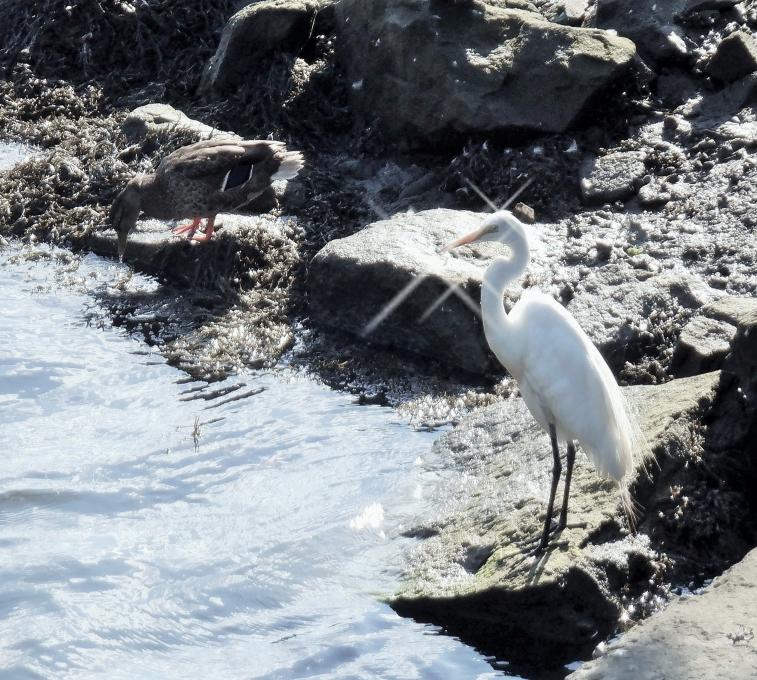 Birds/Waterfowl/Seabirds. From May, until Winter. SAMPLE ABOVE.
Birds/Waterfowl/Seabirds. From May, until Winter. SAMPLE ABOVE. 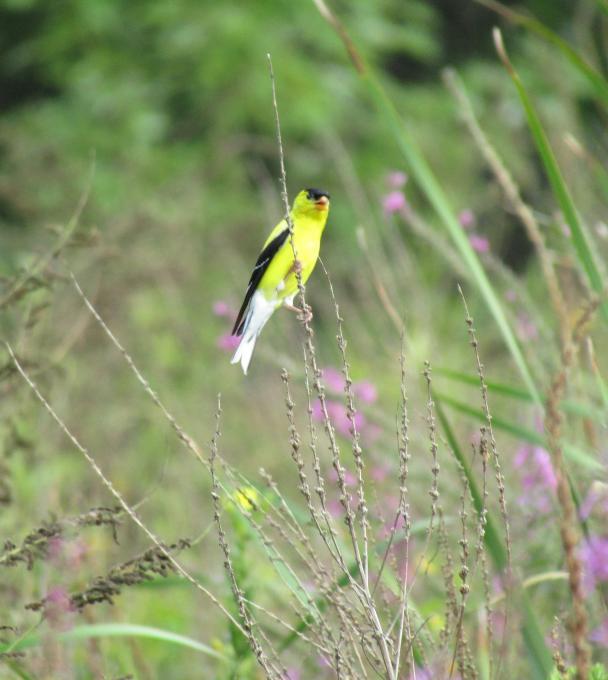 color, into a dark grey. And there is no distinct, 'necktie.' Just a void in that area. Not as finely outlined.
color, into a dark grey. And there is no distinct, 'necktie.' Just a void in that area. Not as finely outlined. 
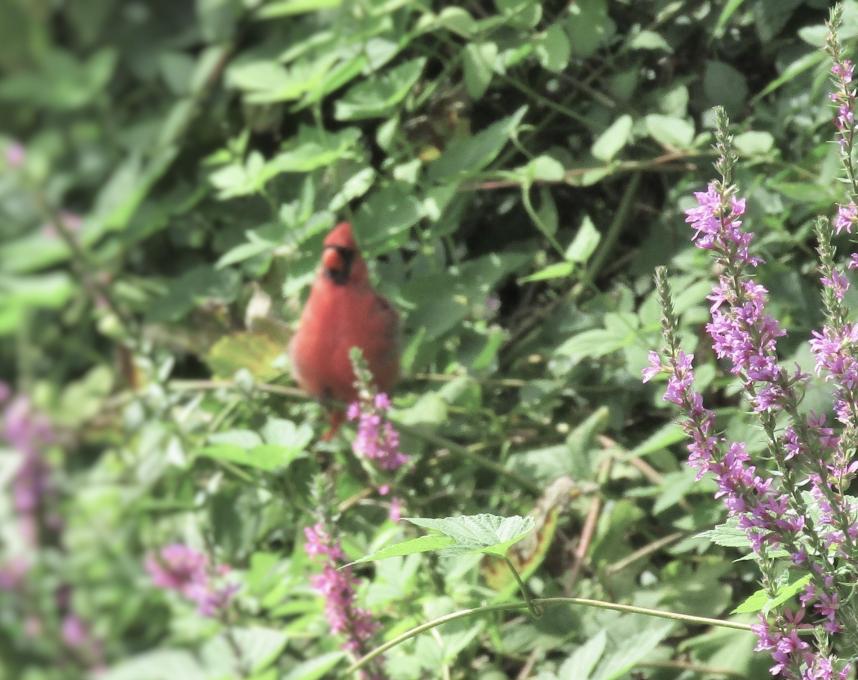
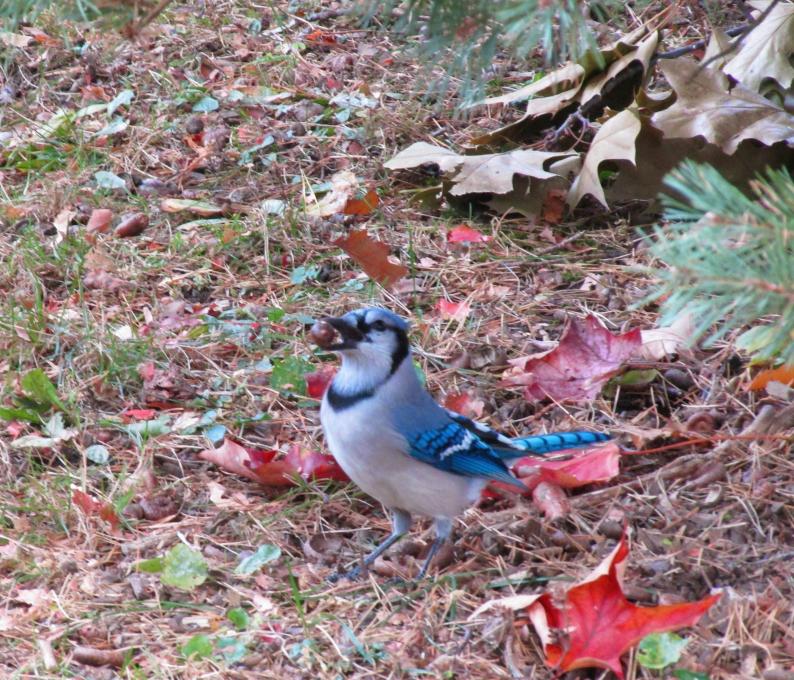 means that they migrate. And are partial seasonal residents, depending on the region/area.
I would assume, that any Ibis/Crane order bird, would migrate to a Southern climate. I do not think a GBH, does better in the cold, than near, or past the south, the MASON DIXON LINE, area. However, some are called, 'SNOWY-EGRETS.' Is that because they can handle the snow, or is it an artistic name, for their white color. I have seen, in the Cornell maps, that Raptors and Terns, migrate through the N.EAST, and past the N.EAST. from North of the USA, and they go down to the south. I think they are decision migrants. Because, they are seen in all areas, in all seasons ? Are there Ospreys in CANADA and GEORGIA, in January, at the same time ? I dunno ?
means that they migrate. And are partial seasonal residents, depending on the region/area.
I would assume, that any Ibis/Crane order bird, would migrate to a Southern climate. I do not think a GBH, does better in the cold, than near, or past the south, the MASON DIXON LINE, area. However, some are called, 'SNOWY-EGRETS.' Is that because they can handle the snow, or is it an artistic name, for their white color. I have seen, in the Cornell maps, that Raptors and Terns, migrate through the N.EAST, and past the N.EAST. from North of the USA, and they go down to the south. I think they are decision migrants. Because, they are seen in all areas, in all seasons ? Are there Ospreys in CANADA and GEORGIA, in January, at the same time ? I dunno ?  The Scarlet T., is red with black wings. The Western T., has yellowish colors, and more markings. Not as solid in coloring.
-----------------------------------------------------------------------------------------------------------------------------------------
The Ruby Throated Hummingbird is an East of the Mississippi-bird, in general population. The Rufous Hummingbird is west and south of the Mississippi. I would assume less population in northern areas, due to the need of flowers to feed from. Are Hummingbirds migrating more south than other birds ? Sooner ?
-----------------------------------------------------------------------------------------------------------------------------------------------
The SandHill Crane, has a scattered population, in its' year round sum of population. The Yellow Bellied FlyCatcher is scattered NE/and South-USA. With some gaps in the USA SE.
PICTURE IS A 'MALE NORTHERN CARDINAL.' NE/USA/MASSACHUSETTS
The Scarlet T., is red with black wings. The Western T., has yellowish colors, and more markings. Not as solid in coloring.
-----------------------------------------------------------------------------------------------------------------------------------------
The Ruby Throated Hummingbird is an East of the Mississippi-bird, in general population. The Rufous Hummingbird is west and south of the Mississippi. I would assume less population in northern areas, due to the need of flowers to feed from. Are Hummingbirds migrating more south than other birds ? Sooner ?
-----------------------------------------------------------------------------------------------------------------------------------------------
The SandHill Crane, has a scattered population, in its' year round sum of population. The Yellow Bellied FlyCatcher is scattered NE/and South-USA. With some gaps in the USA SE.
PICTURE IS A 'MALE NORTHERN CARDINAL.' NE/USA/MASSACHUSETTS
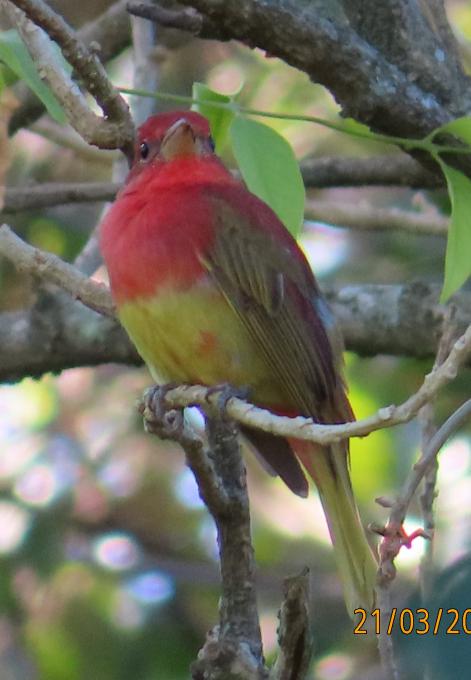
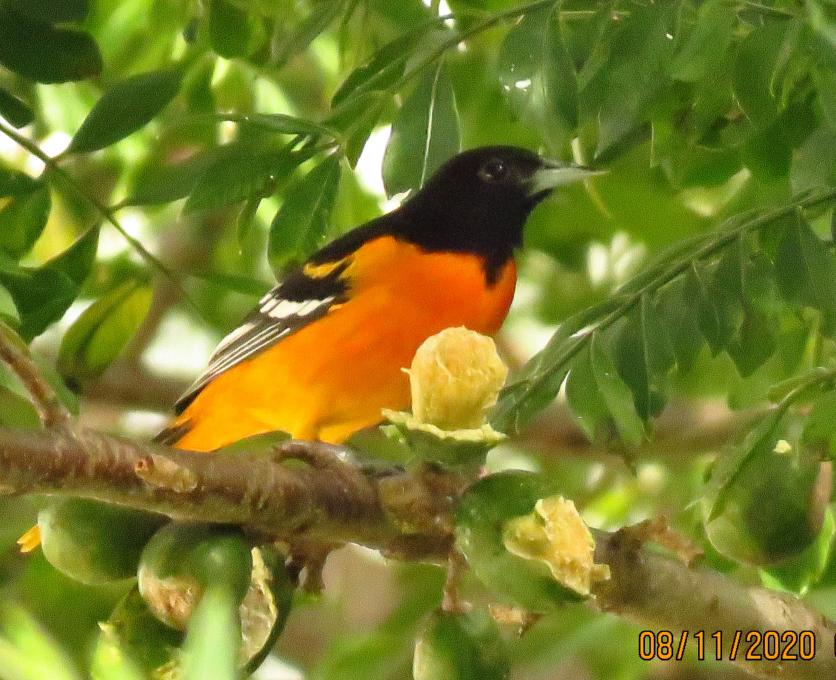 The Summer Tanager is a common migrant in Costa Rica from mid-Sept to late April. I saw this molting bird on 21 March 2020 near my home and the local Birdwatching group help me with ID. The Baltimore Oriole is another migrant from early Sep. to early May and I saw him on 08 November 2020. I found both on my field guide, too.
The Summer Tanager is a common migrant in Costa Rica from mid-Sept to late April. I saw this molting bird on 21 March 2020 near my home and the local Birdwatching group help me with ID. The Baltimore Oriole is another migrant from early Sep. to early May and I saw him on 08 November 2020. I found both on my field guide, too. 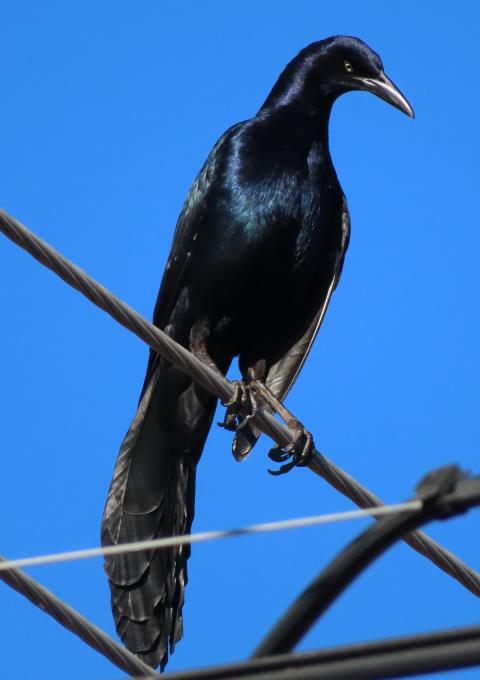
 The Rufous Collared Sparrow and the Great-tailed Grackle are year-round residents in Costa Rica.
The Rufous Collared Sparrow and the Great-tailed Grackle are year-round residents in Costa Rica.